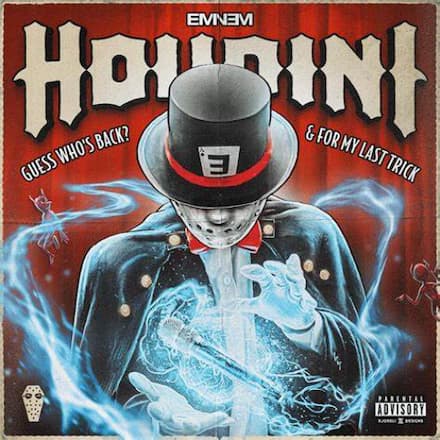Very little that could be deemed exciting seems to happen in popular music anymore.
But the release of Eminem’s new single and accompanying video ‘Houdini’ hits that mark, and seemed last week to become a shared pop-cultural moment for a lot of people.
I also think Eminem – or, more specifically, Slim Shady – is the pop culture figure that is *needed* in this current era. But I’ll get to that later.
Not to be confused with the Melvins’ classic album Houdini from 1993, by the way.
I haven’t seen a single or video generate this much hype or discussion in a long time. And justifiably. ‘Houdini’ is a great track, with an irresistible video.
I’m not necessarily even the biggest Eminem fan, but even I had a smile on my face throughout the whole thing.
Critics can pooh-pooh it all they like, with gripes about the nostalgia element or about ‘tired’ tropes.
But that’s part of the theme of the song in the first place. ‘Houdini’ is deliberately and unapologetically a nostalgia exercise, full of throwbacks and references.
I don’t even harbour any great nostalgia for late 90s or early 2000s popular music: but the Slim Shady thing is probably one of the few things from that time that still could trigger the ‘member-berry’ effect in me.
And the fact is that most popular rap and hip hop is highly self-referential and in-jokey. Eminem was never unique in that – he was just better at it.
Most of what Eminem does is always very self-aware, and often self parody. That was always part of the charm of Slim Shady in particular – whose return (and imminent ‘death’) is the subject of the ‘Houdini’ video.
The criticism of it being overly self-referential also misses the fact that it is also largely self-mocking. And that it deals in established alter-egos and characters – which is something that someone like David Bowie did as well, with Major Tom, Ziggy Stardust, etc.
Whatever the upcoming Death of Slim Shady album ends up being, Bowie also famously did the meta stuff of killing off alter-egos. In fact, in his eerie apotheosis video for ‘Blackstar’, there’s a visual of a dead astronaut thought to represent Major Tom.
And about this ‘Houdini’ video: not that I watch a lot of music videos anymore, but this is probably the most fun music video I’ve seen in ages.
Which isn’t surprising, as Eminem has always been a master of the otherwise dead or dying art of the music video.
Other than someone like Bjork, I can’t think of anyone with a better hit rate when it comes to videos. Though Eminem’s are typically more based in satire than in the kind of visual art you get from a Bjork.
This one – a direct sequel or mirror to the classic ‘Without Me’ video, with additional links to ‘The Real Slim Shady’ and other past hits – is super fun and vibrant, with its retro comic-book framing and superhero tropes.
‘Fun’ is the word I keep coming back to.
Which is something some of the critics are seemingly unable to connect with.
But the Slim Shady era, as distinct from older ‘Eminem’, was always *about* fun, satire, and commentary.
Which is why this song and video – featuring the young, bleach-blonde Shady being transported from the past into 2024 – is a literal recreation of that era and those tropes: but with present-day Eminem struggling to cope with the presence of his former alter-ego.
It’s very meta, obviously: but knowing Eminem, it might also even be a comment on the nostalgia-overload that dominates so much of current popular culture.
Which is also something the critics might be missing.
What hit me immediately is that this era and these past several years – politically, socially, culturally – have probably been in *need* of the Slim Shady character, much more than the early 2000’s needed it.
Because, as much as some people refer (maybe derogatively) to Slim Shady as ‘comedy’ rap, what it actually was at its best was cutting social and cultural commentary and a parodying of the American cultural and media landscape.
Which would seem more appropriate now than it ever was.
It’s kind of similar to how Rage Against the Machine was putting out its hard-hitting stuff in the 90s – an era that was pretty tame compared to the modern political and cultural landscape, where an RATM would be even more impactful.
Eminem actually bringing back Slim Shady for this hyper-toxic era would be a smart commercial move.
Maybe the comic-book-themed return of the costumed ‘Rap Boy’, as shown in the video, is a nod to that idea of the ‘hero’ reappearing at the time he is needed most.
But the title of the upcoming album, The Death of Slim Shady, makes the intent a little ambiguous.
He might be bringing back the character just to kill him off: or it might be a clever misdirection or double-bluff.
To be honest, the digs, snipes or commentary on ‘Houdini’ are pretty tame compared to old Slim Shady fare. I’m not sure if that’s on purpose or not.
Apart from the cancel culture theme, it doesn’t seem as brutal or incisive as you’d expect. Maybe it’s only stage-setting for things to come.
And yet some online, predictably, have already taken offense at some of the lyrics, lashing out at the rapper – and, also predictably, missing the point that cancel culture and the idea of Slim Shady getting Eminem cancelled by the mob is a central theme of the song.
But even just on a marketing level – both the marketing for this single, and with ‘Houdini’ itself as marketing for the album release – it’s been very clever.
The whole Houdini angle is cool, for starters. The artwork for the single, even down to the main font, is in the style of the vintage Harry Houdini posters for his legendary escape acts.
And the rapper putting out a short clip weeks earlier of him face-timing with David Blaine as a tease for the upcoming single/video release was a clever bit of offbeat marketing too.
In the clip, Blaine does a basic glass eating trick, and then Eminem teases with ‘For my last trick, I’m gonna make my career disappear…’
Which, I guess, with the Houdini/magician or escapology theme he’s playing with, makes the David Blaine involvement make sense.
Eminem’s stage-setting and hype generating for these new Slim Shady releases actually does somewhat resemble the kind of hype and build up to one of those old David Blaine endurance spectacles – which were also peaking in the late 90s and early 2000s, and which were themselves largely inspired by Houdini’s acts.
Blaine, for that matter, has always had hate from some quarters, similar to Eminem. But I’ve always been a big fan of what Blaine did, especially the early street magic.
Eminem likewise still has detractors – whether it’s in relation to lyrical offenses, to style, or to simply being a white rapper and way too successful.
But, like I said, I had a smile on my face the entire time I was watching this video.
And I can’t think of anything else in popular music that has gotten that kind of reaction from me in ages.




